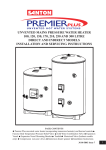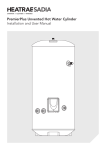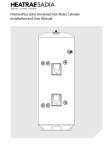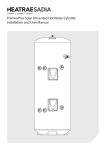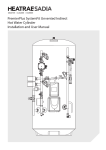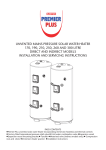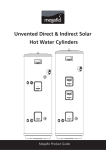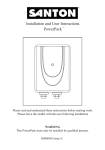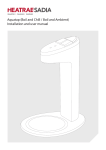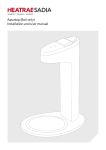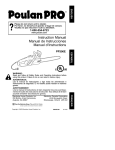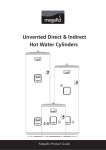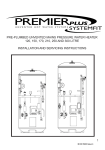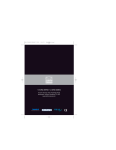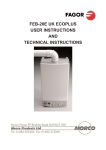Download Santon PP150B Technical data
Transcript
UNVENTED MAINS PRESSURE WATER HEATER 100, 120, 150, 170, 210, 250 and 300 LITRE CAPACITY DIRECT AND INDIRECT MODELS INSTALLATION AND SERVICING INSTRUCTIONS IMPORTANT: PLEASE READ AND UNDERSTAND THESE INSTRUCTIONS BEFORE COMMENCING INSTALLATION. PLEASE LEAVE THIS MANUAL WITH THE CUSTOMER FOR FUTURE REFERENCE. PACK CONTENTS The Santon PremierPlus unvented water heater incorporating immersion heater(s) and thermal controls l Factory fitted temperature/pressure relief valve l Cold water combination valve assembly l Expansion vessel and mounting bracket l Tundish l Motorised valve (indirect models only) l Compression nuts and olives l Immersion heater spanner l Installation instructions Contents Introduction.......................... 3 GENERAL REQUIREments........... 3 Installation – General . ........ 5 INSTALLATION - DISCHARGE ...... 8 Installation - DIRECT UNITS.... 12 Installation - INDIRECT UNITS13 Commissioning....................... 15 Maintenance............................ 16 User Instructions................... 17 Fault Finding & Servicing...... 18 SPARE PARTS................................ 20 GUARANTEE................................ 22 ENVIROMENTAL INFORMATION.. 22 Heat loss.................................. 23 COMMISSIONING CHECK LIST.... 24 SERVICE RECORD......................... 25 TECHNICAL SUPPORT.................. 28 THE BENCHMARK SCHEME Benchmark places responsibilities on both manufacturers and installers. The purpose is to ensure that customers are provided with the correct equipment for their needs, that it is installed, commissioned and serviced in accordance with the manufacturer’s instructions by competent persons and that it meets the requirements of the appropriate Building Regulations. The Benchmark Checklist can be used to demonstrate compliance with Building Regulations and should be provided to the customer for future reference. Installers are required to carry out installation, commissioning and servicing work in accordance with the Benchmark Code of Practice which is available from the Heating and Hotwater Industry Council who manage and promote the Scheme. Visit www.centralheating.co.uk for more information. IMPORTANT NOTE TO USER: PLEASE REFER TO THE USER INSTRUCTIONS SECTION ON PAGES 24 AND 25 FOR IMPORTANT INFORMATION WITH RESPECT TO THE BENCHMARK SCHEME 2 Introduction The Santon PremierPlus cylinder is a purpose designed unvented water heater. The unit has a stainless steel inner vessel, which ensures an excellent standard of corrosion resistance. The outer casing is a combination of resilient thermoplastic mouldings and plastic coated corrosion proofed steel sheet. All products are insulated with CFC free polyurethane foam to give good heat loss performance. (See Table 6, page 23) The unit is supplied complete with all the necessary safety and control devices needed to allow connection to the PremierPlus. All these components are preset and not adjustable. This appliance complies with the requirements of the CE marking directive and is Kiwa approved to show compliance with Building Regulations (Section G3). The following instructions are offered as a guide to installation which must be carried out by a competent plumbing and electrical installer in accordance with Building Regulation G3, The Building Standards (Scotland) Regulations 1990, or The Building Regulations (Northern Ireland). NOTE: Prior to installation the unit should be stored in an upright position in an area free from excessive damp or humidity. GENERAL REQUIREments IMPORTANT: THIS APPLIANCE CAN BE USED BY CHILDREN AGED FROM 8 YEARS AND ABOVE AND PERSONS WITH REDUCED PHYSICAL SENSORY OR MENTAL CAPABILITIES OR LACK OF EXPERIENCE AND KNOWLEDGE IF THEY HAVE BEEN GIVEN SUPERVISORY OR INSTRUCTION CONCERNING USE OF THE APPLIANCE IN A SAFE WAY AND UNDERSTAND THE HAZARDS INVOLVED. CHILDREN SHALL NOT PLAY WITH THE APPLIANCE. CLEANING AND USER MAINTENANCE SHALL NOT BE MADE BY CHILDREN WITHOUT SUPERVISION. WARNING: Do not switch on if there is a possibility that the water in the heater is frozen. SITING THE UNIT The PremierPlus cylinder must be vertically floor mounted. Although location is not critical, the following points should be considered: • The PremierPlus cylinder should be sited to ensure minimum dead leg distances, particularly to the point of most frequent use. • Avoid siting where extreme cold temperatures will be experienced. All exposed pipe work should be insulated. • The discharge pipework from the safety valves must have minimum fall of 1:200 from the unit and terminate in a safe and visible position. • Access to associated controls and immersion heaters must be available to provide for the servicing and mainenance of the system. • Where these controls are installed against a wall a minimum distance of 250mm must be left (see Fig. 1, page 3). • Ensure that the floor area for the PremierPlus cylinder is level and capable of permanently supporting the weight when full of water. (see Table 1, page 3) Fig 1:Siting the Unit WALL Min 250mm Table 1: Unit Weights Type Capacity (litres) Weight of full unit (kg) Weight of unit (Kg) Direct 100 123 23 120 145 25 150 178 28 170 199 29 210 246 36 250 295 45 300 355 55 100 125 25 120 147 27 150 184 31 170 203 33 Min 250mm Indirect 210 251 41 250 300 50 300 360 60 3 WATER SUPPLY Bear in mind that the water supply to the property will be supplying both the hot and cold water requirements simultaneously. It is recommended that the maximum water demand is assessed and the water supply checked to ensure this demand can be satisfactorily met. NOTE: A high water pressure will not always guarantee high flow rates. Wherever possible the PremierPlus supply pipe should be 22mm. We suggest the minimum supply requirements should be 1.5 bar pressure and 20 litres per minute flow-rate. However, at these values outlet flow rates may be poor if several outlets are used simultaneously. The higher the available pressure and flow rate the better the system performance. The PremierPlus cylinder has an operating pressure of 3.5 bar which is controlled by the cold water combination valve assembly. The cold water combination valve assembly can be connected to a maximum pressure of 16 bar. The PremierPlus cylinder is to be used for the storage of wholesum water (max 250mg/l Chloride ). OUTLET/TERMINAL FITTINGS (TAPS, ETC.) The PremierPlus cylinder can be used with most types of terminal fittings. It is advantageous in many mixer showers to have balanced hot and cold water supplies. In these instances a balanced cold water connection should be placed between the Cold Water Combination Valve and the PremierPlus water heater (see Fig.6, page 11). Outlets situated higher than the PremierPlus cylinder will give outlet pressures lower than that at the heater, a 10m height difference will result in a 1 bar pressure reduction at the outlet. All fittings, pipe-work and connections must have a rated pressure of at least 6 bar at 80°C. LIMITATIONS The PremierPlus cylinder should not be used in association with any of the following: • Solid fuel boilers or any other boiler in which the energy input is not under effective thermostatic control, unless additional and appropriate safety measures are installed. • Ascending spray type bidets or any other class 1 back syphonage risk require that a type A air gap be employed. • Steam heating plants unless additional and appropriate safety devices are installed. • Situations where maintenance is likely to be neglected or safety devices tampered with. • Water supplies that have either inadequate pressure or where the supply may be intermittent. • Situations where it is not possible to safely pipe away any discharge from the safety valves. • In areas where the water consistently contains a high proportion of solids, e.g. suspended matter that could block the strainer unless adequate filtration can be ensured. OPERATIONAL SUMMARY (Indirect models in conformance with BS EN 12897:2006) Maximum mains water supply pressure (to 3 bar pressure reducing valve) Operating pressure (pressure reducing valve set pressure - non adjustable) Expansion vessel pressure Expansion relief valve setting T&P relief valve setting Primary coil operating pressure (max) Immersion heater rating (a.c. supply only) 1.6MPa (16 bar) 0.35MPa (3.5 bar) 0.35MPa (3.5 bar) 0.6MPa (6 bar) 1.0MPa/90 °C (10 bar) 1.0MPa (10 bar) 3kW @ 240V 50Hz 2.8kW @ 230V 50Hz Primary Coil ratings (Based on a primary flow rate of 15L/min and a flow temperature of 80 °C) Pressure drop across coils See Table 2, page 7 Storage capacity Weight when full 0.02MPa (0.2bar) See Table 1, Page 3 See Table 1, Page 3 Note: Although the primary coil pressure rating is 1.0Mpa (10 bar) the 2 port zone valve supplied with the cylinder is only rated 0.86MPa (8.6 bar). If the cylinder is to be plumbed into a system delivering 1.0MPa (10 bar) a suitable 2 port zone valve will have to be sourced. 4 Installation – General PIPE FITTINGS All pipe fittings are made via 22mm compression fittings directly to the unit. The fittings are threaded 3/4”BSP male parallel should threaded pipe connections be required. COLD FEED A 22mm cold water supply is recommended, however, if a 15mm (1/2”) supply exists which provides sufficient flow, this may be used (although more flow noise may be experienced). A stopcock or servicing valve should be incorporated into the cold water supply to enable the PremierPlus cylinder and its associated controls to be isolated and serviced. COLD WATER COMBINATION VALVE ASSEMBLY (FIG. 2, page 5) The Cold Water Combination Valve can be connected anywhere on the cold water PremierPlus supply prior to the Expansion Vessel (see Fig. 6, page 11). The Cold Water Combination Valve is installed as a complete one-piece unit. The valve incorporates the Pressure Reducer, Strainer, Expansion Valve and Check Valve. Ensure that the valve is installed with the direction of flow arrows pointing in the right direction. No other valves should be placed between the Cold Water Combination Valve and the PremierPlus unit. The Expansion Valve connection must not be used for any other purpose. Fig. 2: Cold water combination valve Expansion valve Expansion valve outlet (15mm) Cold mains connection (22mm) Outlet connection (22mm) Pressure reducing valve cartridge (3.5bar) DRAIN TAP A suitable draining tap should be installed in the cold water supply to the PremierPlus cylinder between the expansion valve (see Fig. 6, page 11) and the heater at as low a level as possible. It is recommended that the outlet point of the drain pipework be at least 1 metre below the level of the heater (this can be achieved by attaching a hose to the drain tap outlet spigot). 5 EXPANSION VESSEL The expansion vessel accommodates expansion that results from heating the water inside the unit. The expansion vessel is pre-charged at 3.5 bar. The expansion vessel must be connected between the expansion valve (see Fig. 2, page 5) and the PremierPlus cylinder (see Fig. 6, page 11). The location of the expansion vessel should allow access to recharge the pressure as and when necessary, this can be done using a normal car foot pump. It is recommended that the expansion vessel is adequately supported. An expansion vessel wall mounting bracket is supplied for this purpose and should be fitted. SECONDARY CIRCULATION If secondary circulation is required it is recommended that it be connected to the PremierPlus cylinder as shown in Fig. 3, page 6 via a swept tee joint into the cold feed to the unit. A swept tee joint is available as an accessory (order code no. 94 970 033). The secondary return pipe should be in 15mm pipe and incorporate a check valve to prevent backflow. A suitable WRAS approved bronze circulation pump will be required. On large systems, due to the increase in system water content, it may be necessary to fit an additional expansion vessel to the secondary circuit. This should be done if the capacity of the secondary circuit exceeds 10 litres. In direct electric installations where a secondary circulation is required particular attention should be paid by the installer to maintain the return water temperature (guidelines state that a minimum of 55°C return temperature is advisable) . Factors such as, but not limited to, secondary circulation flow rates, minimising heat loss of all secondary circuit pipework and timed operation during periods of high demand are critical to the correct operation and longevity of the heating element(s) and thermostats. Secondary circulation is not recommended for direct electric units using off-peak tariffs where the secondary circulation is not controlled in conjunction with the heat source as performance can be affected. Pipe capacity (copper): 15mm O.D. = 0.13 l/m (10 litres = 77m) 22mm O.D. = 0.38 l/m (10 litres = 26m) 28mm O.D. = 0.55 l/m (10 litres = 18m) Fig 3: Secondary circulation connection Cold supply Swept tee Secondary return Cold inlet connection Check valve Secondary circulation pump HOT WATER OUTLET The hot water outlet is a 22mm compression fitting located at the top of the cylinder. Hot water distribution pipework should be 22mm pipe with short runs of 15mm pipe to terminal fittings such as sinks and basins. Pipe sizes may vary due to system design. 6 Fig 4 - General Dimensions Table 2 - Dimensions and Performance TYPE NOMINAL CAPACITY (litres) Direct 100 100 120 300 315 315 315 250 300 315 210 250 315 170 210 A 150 170 Indirect 120 150 DIMENSIONS (mm) 315 315 B C D 306 493 784 354 500 784 306 616 906 354 616 906 306 800 1090 354 800 1090 306 925 1216 354 927 1216 306 1184 1474 354 1184 1474 306 1437 1726 354 1439 1726 306 1751 2040 354 1754 2040 COIL RATING (kW) 15.2 15.4 15.9 17.3 19.2 18.6 18.8 HEAT UP TIME (mins) 24 24 29 30 34 42 49 HOT WATER DRAW-OFF (Litres ) to 40°C 97 108 135 157 199 240 273 HEATING TIME DIRECT (mins) 99 121 152 173 215 257 310 NOTES: 1. Indirect cylinders tested in conformance with BS EN 12897:2006 2. Heat up time from cold through 45°C, with a primary flow rate of 15L/min at 80°C ± 2°C 3. Direct heating times assume use of lower element only, from cold through 45°C 4. “Cold” is assumed to be 15°C 7 INSTALLATION - DISCHARGE It is a requirement of Building Regulation G3 that any discharge from an unvented system is conveyed to where it is visible, but will not cause danger to persons in or about the building. The tundish and discharge pipes should be fitted in accordance with the requirements and guidance notes of Building Regulation G3. The G3 Requirements and Guidance section 3.50 - 3.63 are reproduced in the following sections of this manual. For discharge pipe arrangements not covered by G3 Guidance advice should be sought from your local Building Control Officer. Any discharge pipe connected to the pressure relief devices (Expansion Valve and Temperature/Pressure Relief Valve) must be installed in a continuously downward direction and in a frost free environment. Water may drip from the discharge pipe of the pressure relief device. This pipe must be left open to the atmosphere. The pressure relief device is to be operated regularly to remove lime deposits and to verify that it is not blocked. G3 REQUIREMENT “...there shall be precautions...to ensure that the hot water discharged from safety devices is safely conveyed to where it is visible but will not cause danger to persons in or about the building.” Notes: Discharge pipe-work D2 can now be a plastic pipe but only pipes that have been tested to a minimum 110°C must be used. Discharge pipe D2 can now be plumbed into the soil stack but only soil stacks that can handle temperatures of 99°C or greater should be used. The following extract is taken from the latest G3 Regulations Discharge pipe D1 3.50 Safety devices such as temperature relief valves or combined temperature and pressure and pressure relief valves (see paragraphs 3.13 or 3.18) should discharge either directly or by way of a manifold via a short length of metal pipe (D1) to a tundish. 3.51 The diameter of discharge pipe (D1) should be not less than the nominal outlet size of the temperature relief valve. 3.52 Where a manifold is used it should be sized to accept and discharge the total discharge form the discharge pipes connected to it. 3.53 Where valves other than the temperature and pressure relief valve from a single unvented hot water system dischargeby way of the same manifold that is used by the safety devices, the manifold should be factory fitted as part of the hot water storage system unit or package. Tundish 3.54 The tundish should be vertical, located in the same space as the unvented hot water storage system and be fitted as close as possible to, and lower than, the valve, with no more than 600mm of pipe between the valve outlet and the tundish (Fig. 5 & Table 3, page 10). Note: To comply with the Water Supply (Water Fittings) Regulations, the tundish should incorporate a suitable air gap. 3.55 Any discharge should be visible at the tundish. In addition, where discharges from safety devices may not be apparent, e.g. in dwellings occupied by people with impaired vision or mobility, consideration should be given to the installation of a suitable safety device to warn when discharge takes place, e.g. electronically operated. Discharge pipe D2 3.56 The discharge pipe (D2) from the tundish should: (a) have a vertical section of pipe at least 300mm long below the tundish before any elbows or bends in the pipework (see Diagram 1, G3), (Fig. 5, page 10); and (b) be installed with a continuous fall thereafter of at least 1 in 200. 3.57 The discharge pipe (D2) should be made of: (a) metal; or (b) other material that has been demonstrated to be capable of safely withstanding temperatures of the water discharged and is clearly and permanently marked to identify the product and performance standard (e.g. as specified in the relevant part of BS 7291). 3.58 The discharge pipe (D2) should be at least one pipe size larger than the nominal outlet size of the safety device unless its total equivalent hydraulic resistance exceeds that of a straight pipe 9m long, i.e. for discharge pipes between 9m and 18m the equivalent resistance length should be at least two sizes larger than the nominal outlet size of the safety device; between 18 and 27m at least 3 sizes larger, and so on; bends must be taken into account in calculating the flow resistance. (See Diagram 1, Table 1, G3), (Fig. 5 & Table 3, page 10) and the worked example. Note: An alternative approach for sizing discharge pipes would be to follow Annex D, section D.2 of BS 6700:2006 Specification for design, installation, testing and maintenance of services supplying water for domestic use within buildings and their curtilages. 3.59 Where a single common discharge pipe serves more than one system, it should be at least one pipe size larger than the largest individual discharge pipe 8 (D2) to be connected. 3.60 The discharge pipe should not be connected to a soil discharge stack unless it can be demonstrated that that the soil discharge stack is capable of safely withstanding temperatures of the water discharged, in which case, it should: (a) contain a mechanical seal, not incorporating a water trap, which allows water into the branch pipe without allowing foul air from the drain to be ventilated through the tundish; (b) be a separate branch pipe with no sanitary appliances connected to it; (c) if plastic pipes are used as branch pipes carrying discharge from a safety device they should be either polybutalene (PB) to Class S of BS 7291-2:2006 or cross linked polyethylene (PE-X) to Class S of BS 7291-3:2006; and (d) be continuously marked with a warning that no sanitary appliances should be connected to the pipe. Note: 1. Plastic pipes should be joined and assembled with fittings appropriate to the circumstances in which they are used as set out in BS EN ISO 1043-1. 2. Where pipes cannot be connected to the stack it may be possible to route a dedicated pipe alongside or in close proximity to the discharge stack. Termination of discharge pipe 3.61 The discharge pipe (D2) from the tundish should terminate in a safe place where there is no risk to persons in the vicinity of the discharge. 3.62 Examples of acceptable discharge arrangements are: (b) to a trapped gully with the end of the pipe below a fixed grating and above the water seal; (c) downward discharges at low level; i.e. up to 100mm above external surfaces such as car parks, hard standings, grassed areas etc. are acceptable providing that a wire cage or similar guard is positioned to prevent contact, whilst maintaining visibility; and (d) discharges at high level: e.g. into a metal hopper and metal downpipe with the end of the discharge pipe clearly visible or onto a roof capable of withstanding high temperature discharges of water and 3m from any plastic guttering system that would collect such discharges. 3.63 The discharge would consist of high temperature water and steam. Asphalt, roofing felt and non-metallic rainwater goods may be damaged by such discharges. Worked example of discharge pipe sizing Fig. 5, page 10: shows a G1/2 temperature relief valve with a discharge pipe (D2) having 4 No. elbows and length of 7m from the tundish to the point of discharge. From Table 3, page 10: Maximum resistance allowed for a straight length of 22mm copper discharge pipe (D2) from a G1/2 temperature relief valve is 9.0m. Subtract the resistance for 4 No. 22mm elbows at 0.8m each = 3.2m Therefore the permitted length equates to: 5.8m 5.8m is less than the actual length of 7m therefore calculate the next largest size. Maximum resistance allowed for a straight length of 28mm pipe (D2) from a G1/2 temperature relief valves equates to 18m. Subtract the resistance of 4 No. 28mm elbows at 1.0m each = 4.0m Therefore the maximum permitted length equates to: 14m As the actual length is 7m, a 28mm (D2) copper pipe will be satisfactory. WARNINGS: • Under no circumstances should the factory fitted temperature/pressure relief valve be removed other than by a competent person. To do so will invalidate any guarantee or claim. • The cold water combination valve assembly must be fitted on the PremierPlus water supply to the PremierPlus cylinder. • No control or safety valves should be tampered with or used for any other purpose. • The discharge pipe should not be blocked or used for any other purpose. • The tundish should not be located adjacent to any electrical components. 9 Table 3 - Sizing of copper discharge pipe (D2) for common temperature relief valve outlet sizes Va lve outle t size Minim um size of discha rge pipe D1 G1/2 15mm G3/4 22mm G1 28mm Minim um size of discha rge pipe D2 from tundish Ma x im um re sista nce a llow e d, e x pre sse d a s a le ngth of stra ight pipe (I.E . no e lbow s or be nds) Re sista nce cre a te d by e a ch e lbow or be nd 22mm 28mm 35mm 28mm 35mm 42mm 35mm 42mm 54mm up to 9m up to 18m up to 27m up to 9m up to 18m up to 27m up to 9m up to 18m up to 27m 0.8m 1.0m 1.4m 1.0m 1.4m 1.7m 1.4m 1.7m 2.3m Fig 5 - Typical discharge Safety device (e.g. Temperature relief valve) Metal discharge pipe (D1) from Temperature relief valve to tundish Tundish 600mm maximum 300mm minimum Discharge below fixed grating (Building Regulation G3 section 3.61 gives alternative points of discharge) Fixed grating Discharge pipe (D2 from tundish, with continuous fall. See Building Regulation G3 section 3.56, Table 4 and worked example) 10 Trapped gully Fig 6 - Typical installation - schematic To hot outlets T&P relief valve Expansion vessel Balanced cold water connection (if required) Cold water combination valve Boost element/ control housing (PP120E to PP300E models only) Isolating valve (not supplied) Mains water supply Element/ controls housing Secondary return (if required) use swept tee Primary return Primary flow NOTE: Primary heating coil fitted on PP100B to PP300B models only Inlet Drain cock (not supplied) Tundish Discharge pipe For notes on secondary circulation please see page 6 11 Fig 7 - Direct Electrical connections (schematic) Direct Wiring Layout Fig 8 - Adjustment details L = RED THERMAL CUT-OUT RESET BUTTON N = BLACK SPINDLE POSITIONS = MINIMUM TEMP 10ºC = MAXIMUM TEMP 72ºC = APPROX 60 °C N L ROTATE SPINDLE CLOCKWISE FOR TEMPERATURE INCREASE AND COUNTER CLOCKWISE FOR TEMPERATURE DECREASE 1.5mm² 3 Core HOFR sheathed cable TEMPERATURE ADJUSTING SPINDLE Installation - DIRECT UNITS PLUMBING CONNECTIONS PremierPlus direct cylinders require the following pipework connections. • Cold water supply to and from inlet controls. • Outlet to hot water draw off points. • Discharge pipework from valve outlets to tundish All connections are 22mm compression. However, 3/4”BSP parallel threaded fittings can be fitted to the primary coil connections if required. ELECTRICAL SUPPLY Direct models are fitted with two 3kW immersion heaters as standard. It is recommended that these should be wired via a suitable controller to BSEN 60730. The PremierPlus MUST be earthed. All wiring to the unit must be installed in accordance with the latest IEE Wiring Regulations and the circuit must be protected by a suitable fuse and double pole isolating switch with a contact separation of at least 3mm in both poles. The live and neutral connections are made directly onto the combined thermostat and thermal cut-out located under the terminal cover(s) mounted on the side of the unit. The earth connection should be made to the earth connection located to the side of the immersion heater boss(es). The supply cable must be routed through the cable gland located on the unit casing beneath the terminal housing. DO NOT operate the immersion heaters until the cylinder has been filled with water. SAFETY DISCONNECT FROM THE MAINS SUPPLY BEFORE REMOVING ANY COVERS. Never attempt to replace the immersion heater(s) other than with the recommended PremierPlus immersion heater(s). DO NOT BYPASS THE THERMAL CUT-OUT(S) IN ANY CIRCUMSTANCES. In case of difficulty contact service support; contact details available at the back of this booklet. 12 Control Housing Details Fig 9 - Indirect Electrical connections (schematic) Element Connections 1 2 3 L N installation - INDIRECT UNITS PLUMBING CONNECTIONS Indirect control wiring 1.5mm² 3 Core HOFR sheathed cable PremierPlus indirect cylinders require the following pipework connections. • Cold water supply to and from inlet controls. • Outlet to hot water draw off points. • Discharge pipework from valve outlets to tundish • Connection to the primary circuit. All connections are 22mm compression. However, 3/4”BSP parallel threaded fittings can be fitted to the primary coil connections if required. ELECTRICAL SUPPLY All units are fitted with a 3kW immersion heater and a combined thermostat and thermal cut-out to control the indirect heating source. The PremierPlus cylinder MUST be earthed. All wiring to the unit must be installed in accordance with the latest IEE Wiring Regulations and the supply circuits must be protected by a suitable fuse and double pole isolating switch with a contact separation of at least 3mm in both poles. All connections are made to the terminal block located under the terminal cover mounted on the side of the unit. The supply cable(s) must be routed through the cable grip(s) in the terminal housing. DISCONNECT FROM MAIN SUPPLY BEFORE REMOVING ANY COVERS. DO NOT BYPASS THE THERMAL CUT-OUT(S) IN ANY CIRCUMSTANCES. Ensure the thermostat and thermal cut-out sensing bulbs are pushed fully into the pockets on the element plate assembly. BOILER SELECTION The boiler should have a control thermostat and non self-resetting thermal cut-out and be compatible with unvented storage water heaters.Where use of a boiler without a thermal cut-out is unavoidable a “low head” open vented primary circuit should be used. The feed and expansion cistern head above the PremierPlus cylinder should not exceed 2.5m. PRIMARY CIRCUIT CONTROL The 2 port motorised valve supplied with the PremierPlus cylinder MUST be fitted on the primary flow to the PremierPlus cylinder heat exchanger and wired in series with the indirect thermostat and thermal cut-out fitted to the unit. Primary circulation to the PremierPlus cylinder heat exchanger must be pumped; gravity circulation WILL NOT WORK. SPACE AND HEATING SYSTEMS CONTROLS The controls provided with the PremierPlus cylinder will ensure the safe operation of the unit within the central heating system. Other controls will be necessary to control the space heating requirements and times that the system is required to function. (See Fig. 9, page 13) The PremierPlus cylinder is compatible with most heating controls, examples of electrical circuits are shown in Figs. 10 and 11 (page 14). However, other systems may be suitable, refer to the controls manufacturers’ instructions, supplied with the controls selected, for alternative system wiring schemes. 13 Fig. 10: Schematic wiring diagram - Basic 2 x 2 port valve system - ‘S-Plan Premier Plus terminal block 2 1 3 3 Zone valve (HTG) Room stat Zone valve (DHW) (supplied) G Br Bl 0 GY 1 3 2 G Br Bl 0 2 1 1 2 3 L (Supply) N 1 2 3 4 5 6 7 8 9 10 1 2 3 4 5 6 7 8 9 10 HTG ON L N DHW ON Programmer Junction box L 2 3 1 2 3 L N 2 2 3 N Boiler Pump NOTES: Control terminal numbering may differ from those shown. Refer to instructions with controls selected. A double pole isolating switch must be installed in the mains supply. All earth connections must be connected back to the mains earth supply. Fig. 11: Schematic wiring diagram - 3 port mid position valve system - ‘Y-Plan’. Must be used in conjunction with 2 port zone valve supplied. Premier Plus terminal block 2 1 3 3 Zone valve (HTG) Zone valve (DHW) (supplied) G W Bl 0 GY G Br Bl 0 2 3 L (Supply) N 1 2 3 4 5 6 7 8 9 10 1 2 3 4 5 6 7 8 9 10 1 2 3 L N 2 HTG ON Programmer DHW ON DHW OFF 1 3 2 Room stat L N Boiler Junction box L 2 3 NOTES: Control terminal numbering may differ from those shown. Refer to instructions with controls selected. A double pole isolating switch must be installed in the mains supply. All earth connections must be connected back to the mains earth supply. 14 2 1 2 N 3 Pump Commissioning At the time of commissioning, please ensure all relevant sections of the Benchmark Checklist, (Page 24 and 25) of this document are completed. FILLING THE UNIT WITH WATER • Check expansion vessel pre-charge pressure. The vessel is supplied precharged to 3.5 bar to match the control pressure of the pressure reducing valve. The precharge pressure is checked using a car tyre gauge by unscrewing the plastic cap opposite the water connection. • Check all connections for tightness including the immersion heater(s). An immersion heater key spanner is supplied for this purpose. • Ensure the drain cock is CLOSED. • Open a hot tap furthest from the PremierPlus cylinder. • Open the PremierPlus stop cock to fill the unit. When water flows from the tap, allow to run for a few minutes to thoroughly flush through any residue, dirt or swarf, then close the tap. • Open successive hot taps to purge the system of air. SYSTEM CHECKS • • • • Check all water connections for leaks and rectify as necessary. Turn off PremierPlus water supply. Remove the pressure reducing valve head work to access the strainer mesh, clean and re-fit. Manually open each relief valve in turn, checking that water is discharged and runs freely through the tundish and out at the discharge point. • Ensure that the valve(s) reseat satisfactorily. DIRECT UNITS Switch on electrical supply to the immersion heater(s) and allow the cylinder to heat up to normal working temperature. If necessary the temperature can be adjusted by inserting a flat bladed screwdriver in the adjustment knob on top of the immersion heater thermostat and rotating, see Fig 8, page 12 for adjustment details. Check the operation of thermostat(s) and that no water has issued from the expansion relief valve or temperature/pressure relief valve during the heating cycle. INDIRECT UNITS Fill the indirect (primary) circuit following the boiler manufacturer’s commissioning instructions. To ensure the PremierPlus cylinder primary heat exchanger is filled, the 2 port motorised valve (supplied) should be manually opened by moving the lever on the motor housing to the MANUAL setting. When the primary circuit is full return the lever to the AUTOMATIC position. Switch on the boiler, ensure the programmer is set to Domestic Hot Water and allow the PremierPlus cylinder to heat up to a normal working temperature. If necessary the temperature can be adjusted by inserting a flat bladed screwdriver in the adjustment knob (located on top of the thermostat mounting bracket - see Fig 8, page 12) and rotating. The minimum thermostat setting is 10°C. The maximum thermostat setting is 72°C. Check the operation of the indirect thermostat and 2 port motorised valve and that no water has issued from the expansion relief valve or temperature/pressure relief valve during the heating cycle. 15 Maintenance MAINTENANCE REQUIREMENTS Unvented hot water systems have a continuing maintenance requirement in order to ensure safe working and optimum performance. It is essential that the relief valve(s) are periodically inspected and manually opened to ensure no blockage has occurred in the valves or discharge pipework. Similarly cleaning of the strainer element and replacement of the air in the expansion vessel will help to prevent possible operational faults. The maintenance checks described below should be performed by a competent person on a regular basis, e.g. annually to coincide with boiler maintenance. After any maintenance, please complete the relevant Service Interval Record section of the Benchmark Checklist on Page 25 of this document. INSPECTION The immersion heater boss can be used as an access for inspecting the cylinder internally. SAFETY VALVE OPERATION Manually operate the temperature/pressure relief valve for a few seconds. Check water is discharged and that it flows freely through the tundish and discharge pipework. Check valve reseats correctly when released. NOTE: Water discharged may be very hot! Repeat the above procedure for the Expansion Relief Valve. STRAINER Turn off the cold water supply, boiler and immersion heaters. The lowest hot water tap should then be opened to de-pressurise the system. Remove the pressure reducing cartridge to access the strainer mesh. Wash any particulate matter from the strainer under clean water. Re-assemble ensuring the seal is correctly fitted. DO NOT use any other type of sealant. DESCALING IMMERSION HEATER(S) Before removing the immersion heater(s) the unit must be drained. Ensure the water, electrical supply and boiler are OFF before draining. Attach a hosepipe to the drain cock having sufficient length to take water to a suitable discharge point below the level of the unit. Open a hot tap close to the unit and open drain cock to drain unit. IMMERSION REMOVAL Open the cover(s) to the immersion heater housing(s) and disconnect wiring from immersion heater(s) thermostat(s). Remove thermostat by carefully pulling outwards. Remove thermostat capillary sensors from the pockets on the immersion heater. Unscrew immersion heater backnut(s) and remove immersion heater from the unit. A key spanner is supplied with the cylinder unit for easy removal/tightening of the backnut(s). Over time the immersion heater gasket may become stuck to the mating surface. To break the seal insert a round bladed screwdriver into one of the pockets on the immersion heater and gently lever up and down. Carefully remove any scale from the surface of the element(s). DO NOT use a sharp implement as damage to the element surface could be caused. Ensure sealing surfaces are clean and seals are undamaged, if in doubt fit a new gasket (part number 95 611 822). Replace immersion heater(s) ensuring the lower (90° angled) element hangs vertically downwards towards the base of the unit. It may be helpful to support the immersion heater using a round bladed screwdriver inserted into one of the thermostat pockets whilst the backnut is tightened. Replace thermostat capillaries into pocket. Replace the immersion heater thermostat by carefully plugging the two male spade terminations on the underside of the thermostat head into the corresponding terminations on the element. Rewire, check, close and secure immersion heater housing cover(s). EXPANSION VESSEL CHARGE PRESSURE Remove the dust cap on top of the vessel. Check the charge pressure using a tyre pressure gauge. The pressure (with system de-pressurised) should be 0.35MPa (3.5 bar). If it is lower than the required setting it should be re-charged using a tyre pump (Schrader valve type). DO NOT OVER-CHARGE. Re-check the pressure and when correct replace the dust cap. RE-COMMISSIONING Check all electrical and plumbing connections are secure. Close the drain cock. With a hot tap open, turn on the cold water supply and allow unit to refill. DO NOT switch on the immersion heater(s) or boiler until the unit is full. When water flows from the hot tap allow to flow for a short while to purge air and flush through any disturbed particles. Close hot tap and then open successive hot taps in system to purge any air. When completely full and purged check system for leaks. The heating source (immersion heater(s) or boiler) can then be switched on. DIRECT UNITS Switch on electrical supply to the immersion heater(s) and allow to heat up to normal working temperature (60ºC recommended). If necessary the temperature can be adjusted by inserting a flat bladed screwdriver in the adjustment knob on top of the immersion heater thermostat and rotating, (see Fig 8, page 12) for adjustment details. Check the operation of thermostat(s) and that no water has issued from the expansion relief valve or temperature/pressure relief valve during the heating cycle. 16 User Instructions WARNINGS IF WATER ISSUES FROM THE TEMPERATURE/PRESSURE RELIEF VALVE ON THE PREMIERPLUS CYLINDER SHUT DOWN THE BOILER. DO NOT TURN OFF ANY WATER SUPPLY. CONTACT A COMPETENT INSTALLER FOR UNVENTED WATER HEATERS TO CHECK THE SYSTEM. DO NOT TAMPER WITH ANY OF THE SAFETY VALVES FITTED TO THE PREMIERPLUS SYSTEM. IF A FAULT IS SUSPECTED CONTACT A COMPETENT INSTALLER. BENCHMARK The PremierPlus cylinder is covered by the Benchmark Scheme which aims to improve the standards of installation and commissioning of domestic heating and hot water systems in the UK and to encourage regular servicing to optimise safety, efficiency and performance. Benchmark is managed and promoted by the Heating and Hot water Industry Council. For more information visit www.centralheating.co.uk. Please ensure that the installer has fully completed the Benchmark Checklist (Page 24 and 25) of this manual and that you have signed it to say that you have received a full and clear explanation of its operation. The installer is legally required to complete a commissioning checklist as a means of complying with the appropriate Building Regulations (England and Wales). All installations must be notified to Local Area Building Control either directly or through a Competent Persons Scheme. A Building Regulations Compliance Certificate will then be issued to the customer who should, on receipt, write the Notification Number on the Benchmark Checklist. This product should be serviced regularly to optimise its safety, efficiency and performance. The service engineer should complete the relevant Service Record on the Benchmark Checklist after each service. TEMPERATURE CONTROLS – DIRECT UNITS IMMERSION HEATER(S) A combined adjustable thermostat and thermal cut-out is provided for each immersion heater. The thermostat is factory set to give a water storage temperature of approx. 55° to 60°C. Access to the thermostat can be made by opening the immersion heater cover - DISCONNECT THE ELECTRICAL SUPPLY BEFORE OPENING THE COVER(S). Temperature adjustment is made by inserting a flat bladed screwdriver in the slot on the adjustment disc on top of the thermostat and rotating, (see Fig 8, page 12) for adjustment details. If in any doubt contact a competent electrician. DO NOT bypass the thermal cut-out(s) in any circumstances. TEMPERATURE CONTROLS - INDIRECT UNITS The PremierPlus cylinder units are fitted with a combind thermostat and thermal cut-out. These controls must be wired in series with the 2 port motorised zone valve supplied to interrupt the flow of primary water around the heat exchanger coil when the control temperature has been reached. The controls are located within the lower terminal housing along with the immersion heater thermostat. The thermostat is factory set to give a water storage temperature of approx. 55°C to 60°C. Access to the thermostat can be made by opening the terminal housing cover - DISCONNECT THE ELECTRICAL SUPPLY BEFORE OPENING THE COVER. Temperature adjustment is made by inserting a flat bladed screwdriver in the adjustment knob and rotating. The minimum thermostat setting is 10°C. The maximum thermostat setting is 72°C. (see Fig 8, page 12) for adjustment details. If in any doubt contact a competent electrician. An immersion heater is also provided for use should the indirect heat source be shut down for any purpose. The immersion heater control temperature is set using the immersion heater thermostat. DO NOT bypass the thermal cut-out(s) in any circumstances. FLOW PERFORMANCE When initially opening hot outlets a small surge in flow may be noticed as pressures stabilise. This is quite normal with unvented systems. In some areas cloudiness may be noticed in the hot water. This is due to aeration of the water, is quite normal and will quickly clear. OPERATIONAL FAULTS Operational faults and their possible causes are detailed in the Fault Finding section of this book, (p.19). It is recommended that faults should be checked by a competent installer.The air volume within the expansion vessel will periodically require recharging to ensure expanded water is accommodated within the unit. A discharge of water INTERMITTENTLY from the expansion valve will indicate the air volume has reduced to a point where it can no longer accommodate the expansion. 17 Fault Finding & Servicing IMPORTANT • After servicing, complete the relevant Service Interval Record section of the Benchmark Checklist located on page 24 and 25 of this document. • Servicing should only be carried out by competent persons in the installation and maintenance of unvented water heating systems. • Any spare parts used MUST be authorised Santon parts. • Disconnect the electrical supply before removing any electrical equipment covers. • NEVER bypass any thermal controls or operate system without the necessary safety valves. • Water contained in the PremierPlus cylinder may be very hot, especially following a thermal control failure. Caution must be taken when drawing water from the unit. SPARE PARTS A full range of spare parts are available for the PremierPlus cylinder range (See Table 5 Page 20). Refer to the technical data label on the unit to identify the model installed and ensure the correct part is ordered. You will need to quote the serial number which is printed on the data label. FAULT FINDING The fault finding chart (p.19) will enable operational faults to be identified and their possible causes rectified. Any work carried out on the PremierPlus cylinder unvented water heater and its associated controls MUST be carried out by a competent installer for unvented water heating systems. In case of doubt contact service support (see contact details on back page). WARNING DO NOT TAMPER WITH ANY OF THE SAFETY VALVES OR CONTROLS SUPPLIED WITH THE PREMIERPLUS CYLINDER AS THIS WILL INVALIDATE ANY GUARANTEE. 18 Table 4 - Fault finding chart Fault No hot water flow Possible Cause Remedy Mains water supply off Check and open stop cock Strainer blocked Turn off water supply. Remove strainer and clean Cold water combination valve incorrectly Check and refit as required fitted Direct immersion heater not switched on Check and switch on Water from hot tap is cold Water discharges from expansion valve Water discharges from T&P relief valve Milky water Direct immersion heater thermal cut-out has operated Check, reset by pushing button on thermostat Indirect programmer set to central heating only Check, set to domestic hot water programme Indirect boiler not working Check boiler operation. If fault is suspected consult boiler manufacturer’s instructions Indirect thermal cut-out has operated Check, reset by pushing button on thermostat Check operation of indirect thermostat Indirect motorised valve not connected correctly Check wiring and/or plumbing connections to motorised valve INTERMITTENTLY Expansion vessel charge pressure has reduced below 3.5 bar, or set to high See Maintenance section (p.16) for re-charging of expansion vessel procedure CONTINUALLY cold water combination valve pressure reducer not working correctly. Expansion valve seat damaged Check pressure from cold water combination valve. If greater than 3.5 bar replace pressure reducing valve Remove expansion valve cartridge, check condition of seat. If necessary fit new expansion valve Thermal control failure NOTE: water will be very hot Switch off power to immersion heater(s) and shut down boiler. DO NOT turn off water supply. When discharge stops check all thermal controls, replace if faulty Oxygenated water Water from a pressurised system releases oxygen bubbles when flowing. The milkiness will disappear after a short while 19 SPARE PARTS A full range of spare parts are available for the PremierPlus range. Refer to the Techincal Data label on the unit to identify the model installed and ensure the correct part is ordered. Table 5 - Spares list DESCRIPTION PART NO. 1 Immersion heater (lower) 95 606 984 2 Immersion heater (upper) 95 606 986 3 Immersion heater gasket 95 611 822 4 Immersion heater backnut 95 607 869 5 Immersion heater key 95 607 861 6 Tundish 95 605 838 7 Expansion valve - 6 bar 95 605 899 8 Cold water combination valve complete 95 605 897 9 Cold water combination body 95 605 900 10 Pressure reducing valve cartridge 3.5 bar 95 605 898 11 Temperature/Pressure Relief Valve 95 605 810 12 Expansion vessel 12 litre (100, 120 and 150 litre models) 95 607 863 13 Expansion vessel 18 litre (170 and 210 litre models) 95 607 864 14 Expansion vessel 24 litre (250 and 300 litre models) 95 607 612 15 Blanking plate assembly 95 605 881 16 95 607 838 17 Nut & olive pack (4 of each) Direct Combined thermostat and Thermal cut-out 18 Indirect Combined thermostat and Thermal cut-out 95 612 716 19 6 Way Terminal block 95 607 933 20 3 Way Terminal block 95 607 932 21 Motorised 2 port valve 95 605 819 22 Terminal Shroud 95 606 993 95 612 717 Fig. 12 8 10 Outlet Connection (22mm) 9 Outlet Connection (15mm) Cold Mains Connection (22mm) 7 20 Fig. 13 4 3 22 18 4 17 11 2 20 17 3 22 1 19 21 GUARANTEE WARNING: Should the factory fitted temperature and pressure relief valve be tampered with or removed your guarantee will be invalidated. Neither the distributor nor manufacturer shall be responsible for any consequential damage howsoever caused. Guarantee Terms Santon guarantees the PremierPlus against faulty manufacture or materials for a period of 2 years from the date of purchase including parts and labour. This 2 year guarantee is extended to 5 years for the cold water control valve and expansion vessel, and to 30 years for the stainless steel inner vessel. These guarantees are valid provided that: The PremierPlus has been installed by a competent installer and as per the instructions contained in the installation manual and all relevant Codes of Practice and Regulations in force at the time of installation. Any disinfection has been carried out in accordance with BS 6700. The PremierPlus has not been modified in any way other than by heateam approved engineers. The PremierPlus has only been used for the storage of wholesome water (max. 250mg/l chloride). The PremierPlus has not been subjected to frost, nor has it been tampered with or been subjected to misuse or neglect. No factory fitted parts have been removed for unauthorised repair or replacement. The Benchmark™ Commissioning Checklist Service Record included in this product guide has been completed. Regular maintenance has been carried out by a competent person in accordance with the requirements set out in the maintenance section of the installation manual and any replacement parts used should be authorised Santon spare parts. Annual Services are available from heateam, the service division of Santon. Please contact heateam on Tel: 0844 871 1530 for further details. Within 60 days of purchase the owner completes and returns the certificate supplied to register the product. Evidence of purchase and date of supply must be submitted upon making a claim. This guarantee is not valid for installations outside the United Kingdom. For installations outside of the United Kingdom, please contact either the Santon Export Department on Tel: +44 1603 420271 or Baxi International on Tel: +44 1926 478323 for further details of the guarantee terms and conditions applicable. The unit is not guaranteed against damage due to frost. This guarantee does not affect your statutory rights. ENVIROMENTAL Products are manufactured from many recyclable materials. At the end of their useful life they should be disposed of at Local Authority Recycling Centre in order to realise the full environmental benefits. Insulation is by means of an approved CFC/HCFC free polyurethane foam with an ozone depletion factor of zero. 22 HEAT LOSS Table 6: Standing heat losses (based on an ambient air temperature of 20°C and a stored water temperature of 65°C) Nominal Capacity (Litres) Standing Heat Loss per day (kWh/24h) per year (kWh/365d) 100 1.14 416.1 120 1.25 456.3 150 1.45 529.3 170 1.63 595.0 210 1.91 697.2 250 2.22 810.3 300 2.52 919.8 23 24 25 Notes: 26 Notes: 27 Spares Stockists Electric Water Heating Co. 2 Horsecroft Place Pinnacles Harlow Essex CM19 5BT Tel: 0845 0553811 E-Mail: [email protected] SPD Special Product Division Units 9 & 10 Hexagon Business Centre Springfield Road Hayes Middlesex UB40 0TY Tel: 0208 5730574 Parts Center Network 65 Business Park Bentley Wood Way Burnley Lancashire BB11 5ST Tel: 01282 834403 www.partscenter.co.uk Newey & Eyre Specialist Products Division Please Contact your Local Branch UK Spares Ltd Unit 1155 Aztec West Almondsbury Bristol BS32 4TF Tel: 01454 620500 William Wilson Ltd Unit 3A 780 South Street Whiteinch Glasgow G14 0SY Tel: 0141 434 1530 The policy of PremierPlus is one of continuous product development and, as such, we reserve the right to change specifications and guarantee terms and conditions without notice. Customer Service Tel: Fax: E-mail: Santon Hurricane Way Norwich Norfolk NR6 6EA © 2012 28 0844 871 1530 0844 871 1528 [email protected] 36006153_issue_01




























